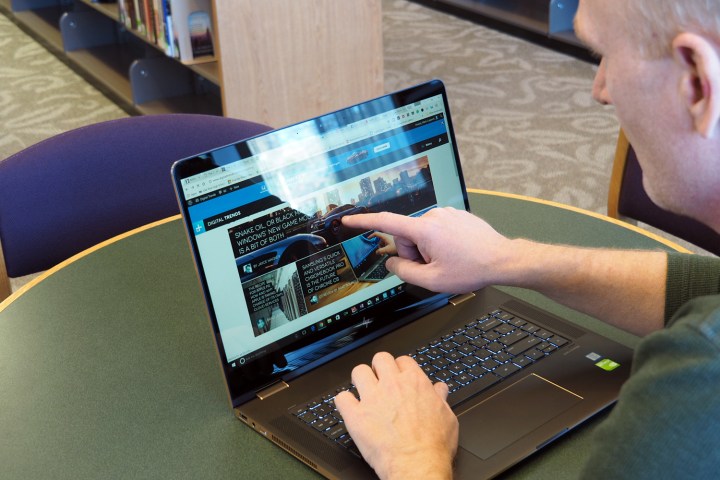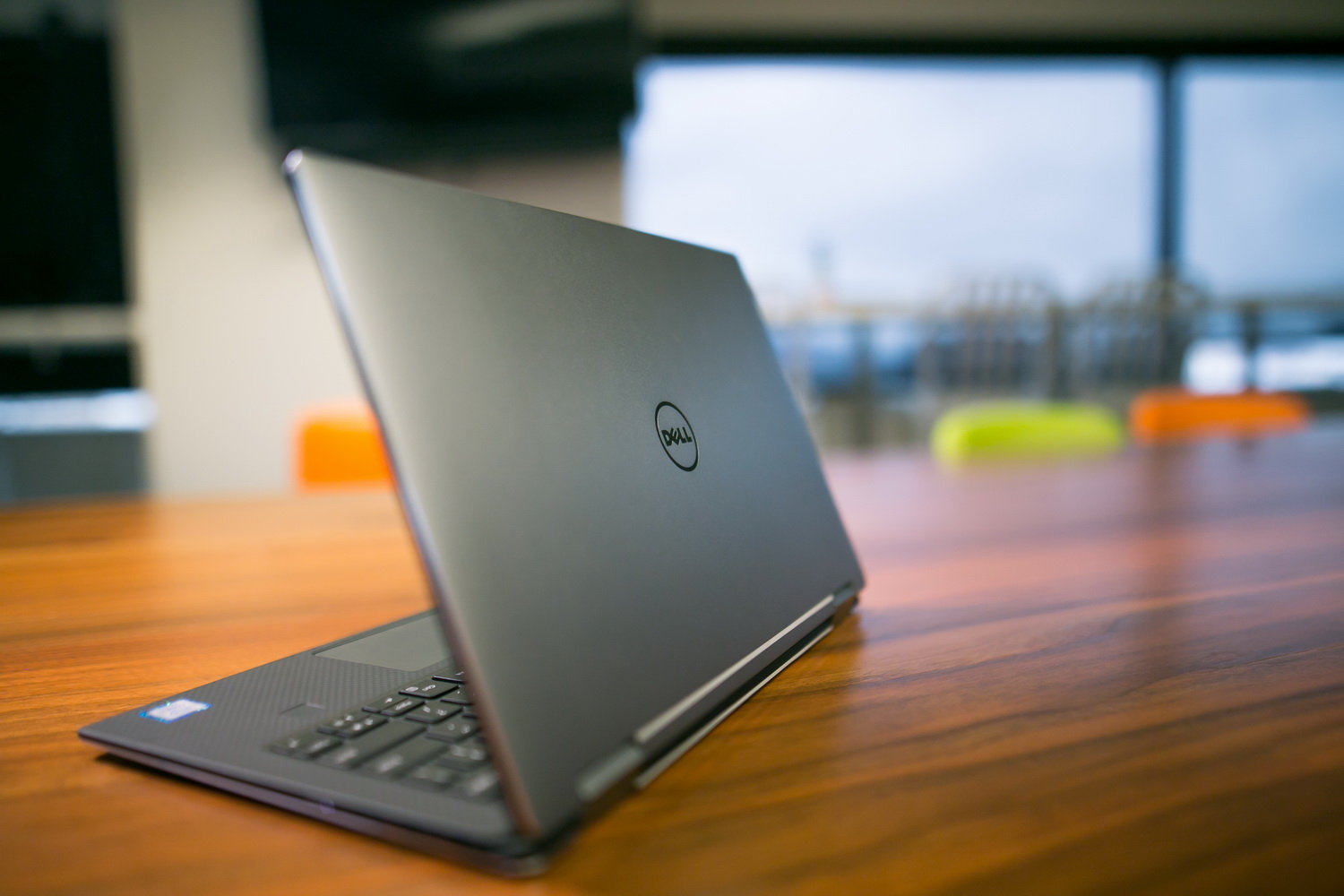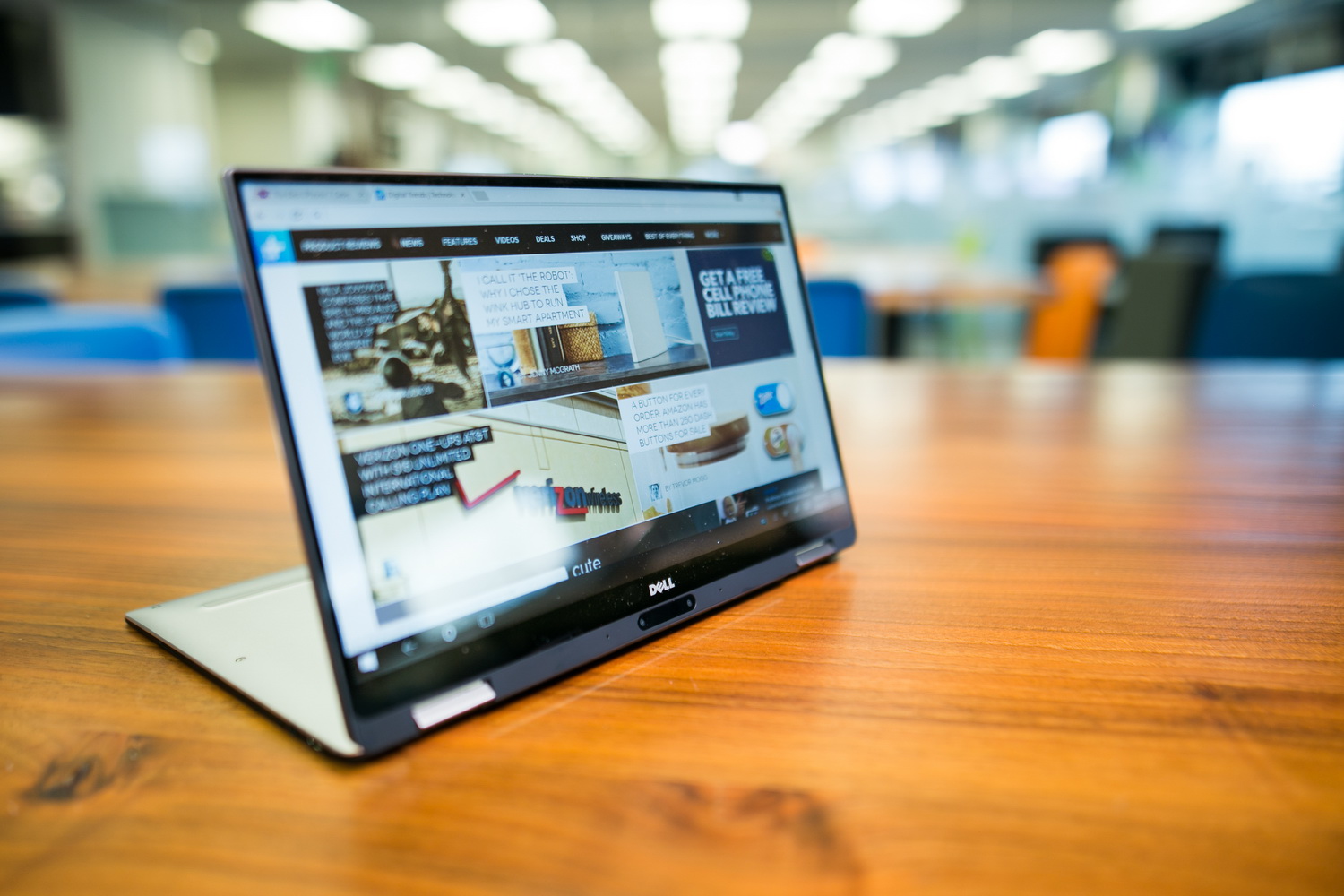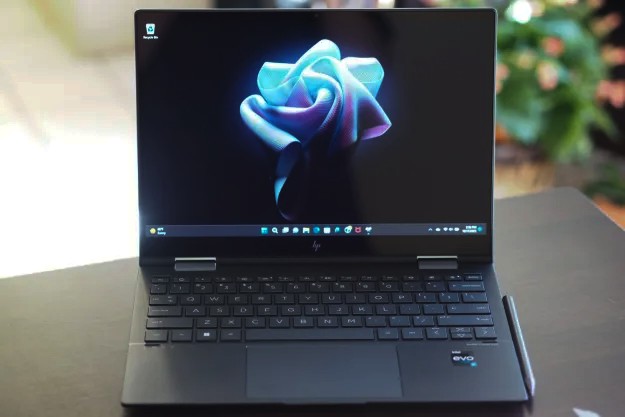
Dell, on the other hand, was late to the premium Windows 10 2-in-1 market, arriving at the beginning of 2017 with its XPS 13 2-in-1 machine. Taking everything that was already good about the outstanding XPS 13 notebook, Dell’s hybrid quickly took its place as one of the best convertible 2-in-1s around.
Now, HP has updated the Spectre x360 13, adding in a missing 4K UHD display option along with an excellent active pen. This brings HP’s 2-in-1 more in line with the XPS 13 2-in-1 in terms of specifications and functionality, and so we thought it made sense to compare these two machines to see which one comes out on top.
Specification comparison
|
Dell XPS 13 2-in-1  |
HP Spectre x360 13  |
|
| Dimensions | 11.98 x 7.8 x .54-.32 inches | 12.07 x 8.58 x .55 inches |
| Weight | 2.7 pounds | 2.98 pounds |
| Processor | 7th Generation Intel Core i5 or i7 Y-Series dual-core | 7th Generation Intel Core i5 or i7 dual-core |
| RAM | 4GB, 8GB, or 16GB LPDDR3 | 8 or 16GB DDR4 |
| Display | 13.3-inch IPS touchscreen, Full HD or QHD+ | 13.3-inch IPS touchscreen, Full HD or 4K |
| Resolution | Full HD (1,920 x 1,080) or QHD+ (3,200 x 1,800) | Full HD (1,920 x 1,080) or 4K (3,840 x 2,160) |
| Storage | 128GB, 256GB, 512GB, 1TB PCIe SSD | 256GB, 512GB, 1TB PCIe SSD |
| Networking | 802.11ac 2×2, Bluetooth 4.2 | 802.11ac 2×2, Bluetooth 4.2 |
| Ports | 1 x USB 3.1 Type-C, 1 x USB Type-C with Thunderbolt 3, 3.5mm Headset, microSD reader | 1 x USB 3.1 Type-A, 2 x USB Type-C with Thunderbolt 3, 3.5mm Headset |
| Webcam | 1080p webcam | 1080p webcam with IR camera and Windows Hello support |
| Operating System | Windows 10 | Windows 10 |
| Battery | 46 watt-hours | 57.8 watt-hours |
| Price | $1,000+ | $1,090+ |
| Availability | Available now | Available now (some configurations) |
| Review | 4 out of 5 stars | 4 out of 5 stars |
Neither offers excellent connectivity
The Spectre x360 13 is equipped with a fair number of ports, but it’s nothing to write home about. There are two USB 3.1 Type-C ports, both with charging and Thunderbolt 3 support. In addition, the machine supports legacy devices with a USB 3.1 Type-A port and a 3.5mm headset jack.
The XPS 13 2-in-1 gives up the past almost completely, offering just two USB 3.1 Type-C connections, one of which supports Thunderbolt 3 with four lanes of PCIe Gen 3 available. The only nods to legacy support include a microSD card slot and a 3.5mm headset jack.
With an additional
Winner: HP Spectre x360 13
Neither design breaks new ground
The refreshed Spectre x360 13 uses almost exactly the same design as its predecessor, which means it’s reasonably thin and light while still offering up real seventh-generation Intel Core processors and decent battery capacity. It’s made from machined aluminum, utilizes a solid 360-degree hinge that is smooth in operation and holds the display firmly in place, and it’s simply a nice looking machine.
HP did make one change to the design, however, that should appeal to anyone who considers the Spectre x360 13’s silver color scheme to be a little pedestrian. Specifically, the company brought back its “ash silver with chrome accents” aesthetic to the 13-inch model, after a brief hiatus. The dark gray adds some understated elegance to HP’s machine, and while it might not be for everyone, it’s a nice addition — while adding a scant $10 to the price.
The Dell XPS 13 2-in-1, on the other hand, pays homage to one of the best 13-inch traditional notebooks on the market. In short, it looks and feels just like the XPS 13, with the same aluminum lid and base with carbon fiber lining the keyboard deck and providing structural support. If you look at the two machines side by side, only the highly functional 360-degree hinge and a chassis that’s just a bit thinner gives away the 2-in-1 version.
It’s a good, conservative design that doesn’t break any new ground and doesn’t really need to. Dell has taken a very strong “if it’s not broke, don’t fix it” approach to the XPS 13 2-in-1, and we can’t really complain.
Comparing the HP and the Dell, however, leaves us in the mood to gives some additional points for breaking the mold and giving users the option of a less conservative design. We think HP deserves some kudos for offering a little excitement with the refreshing Spectre x360 13, and so it wins this round.
Winner: HP Spectre x360 13
The hardware makes a difference
The HP Spectre x360 13 offers a choice between seventh-generation Intel Core processors, namely the Core i5-7200U and the Core i5-7500U, meaning you’re not sacrificing performance for the relatively thin-and-light chassis. You can stock up with either 8GB or 16GB RAM, and storage options range from 256GB to 1TB SSDs.
The Dell XPS 13 2-in-1 uses seventh-generation Core “Y-Series” processors, which were once known as Core M, and are low-powered CPUs that usually offer reduced performance over the “full” Core line. Options include Core i5-7Y54 and Core i7-7Y75 CPUs, and the XPS 2-in-1 can be loaded up with 4, 8, or 16GB of
Note that Dell has implemented a special Dynamic Power Mode that ups the performance over typical Y-Series machines for short periods of time. In our testing, we found that the extra burst of power was effective but didn’t quite close the gap.
The HP provides the more predictable and reliable performance of full-power Core processors and its minimum
Winner: HP Spectre x360 13
Two solid displays, but a clear winner
Until its most recent refresh, the HP Spectre X360 13 offered a very nice Full HD (1,920 x 1,080) 13.3-inch display nestled inside small bezels to the left and right. Although the display offers good contrast, color accuracy and gamut, and brightness, the machine was held back by its lack of a higher-resolution option. HP has now rectified this situation, offering a new
The Dell XPS 13 2-in-1 offers two display options, Full HD and a QHD+ (3,200 x 1,800), that are likely the same as the ones found in the XPS 13. We found the Full HD model to have excellent contrast and solid color gamut coverage, but color accuracy wasn’t the best and brightness was also a bit lower than average.
We do prefer the higher
Accordingly, we’re giving the nod to the HP here.
Winner: HP Spectre x360 13
Input options are closely matched
The HP Spectre x360 13 has a full-sized keyboard that takes up most of the available space on the keyboard deck, with mostly full-sized keys and with the navigation keys in their own row to the right. We liked the keyboard’s layout, for the most part, only quibbling about the small up and down arrow keys. Keyboard feel was good but not necessarily great.
HP uses its wide format touchpad that’s relatively large and takes some getting used to given that your palms will rest on the touchpad during use. Palm rejection worked well, however, and the Synaptics drivers were solid and supported the expected multi-touch gestures. It doesn’t, however, support Microsoft’s Precision Touchpad spec, and so it’s not quite as smooth as the best examples of those that do.
The Dell XPS 13 2-in-1 has a very solid keyboard that sacrifices some size, suffering from a smaller-than-usual backspace key. However, key travel is excellent and the keyboard feels great, at least as good as the excellent keyboard on the XPS 13.
The touchpad, however, was a bit small, particularly compared to the larger touchpads on many other new machines. Performance is fine, with good responsiveness and Microsoft Precision Touchpad support. It just didn’t knock us out.
Another change to the new Spectre x360 13 is the addition of active pen technology. The previous 2016 version didn’t have an active digitizer at all, and so Windows 10 Ink support was impossible. Now the HP Active Pen, based on the same N-Trig technology as Microsoft’s Surface machines, is included. The Dell XPS 13 2-in-1 also offers an active pen option, although it adds $50 to the price.
Finally, both machines support Windows 10 Hello login. The XPS 13 2-in-1 uses a fingerprint scanner, while the Spectre x360 13 uses an infrared facial scanner. All in all, we think getting information into both machines is equally efficient.
Winner: Tie
All-day portability, either way
The HP Spectre x360 13 is a relatively thin and light Windows 10 2-in-1, coming in at 12 inches wide, 8.58 inches deep, and 0.55 inches thick, while weighing a reasonable 2.89 pounds. Interestingly, that’s just slightly thicker and heavier than the .54 inches and 2.85 pounds of the previous model. Apparently HP, as it did with the larger 15-inch model, increased thickness and weight to accommodate a slightly larger battery, in this case going from 56 watt-hours to 57.8 watt-hours.
In our testing prior to the refresh, battery life was strong at four hours and 54 minutes in our demanding Peacekeeper battery test, and 10 hours and 43 minutes in our video looping test. Those are impressive results for the class.
The Dell XPS 13 2-in-1 is just a bit more svelte, at 11.98 inches wide, 7.8 inches deep, and tapering from 0.54 inches to 0.32 inches thick. It weighs 2.7 pounds. The battery is significantly smaller than its XPS 13 notebook sibling, at 46 watt-hours versus 60 watt-hours.
Nevertheless, the XPS 13 2-in-1 still manages to last almost exactly as long as the Spectre x360 13 with its much larger battery capacity. Dell’s machine lasted an identical four hours and 54 minutes in Peacekeeper, and looped our test video for 10 hours and 49 minutes.
Both machines were equipped with Full HD displays as tested, and so will likely show shorter battery life with their higher-resolution panels. The Dell uses slower Intel Y-Series CPUs, however, and so the choice to put in a smaller battery limits the value of the lower-powered processors. Given that there’s so little difference in size and weight between the two machines, we have to give the win to HP for achieving the same battery life with faster Intel Core CPUs.
Winner: HP Spectre x360 13
Pricing and availability
The entry-level Spectre x360 13 starts out at $1,090 for an Intel Core i5-7200U, 8GB of
Dell’s pricing on the XPS 13 2-in-1 has a lower entry price, at $1,000, but that’s for a lower-spec’d configuration with a Core i5-7Y54, 4GB of
In short, Dell has priced its own Windows 10 2-in-1 at a bit of a premium. It’s $200 more than the Spectre x360 13 with power-user specs. Clearly, HP offers significantly better value and wins this round.
Winner: HP Spectre x360 13
Conclusion
The Spectre x360 13 and XPS 13 2-in-1 are both excellent examples of the increasingly wide and deep Windows 10 PC ecosystem. They demonstrate just how good things have gotten — no matter what kind of PC you want, there’s likely to be a great option out there for you.
Not long ago, we considered Dell’s XPS 13 2-in-1 to be perhaps the best example of the 13-inch Windows 10 convertible and we gave it our Top Tech of CES 2017 Award for Computing. That was before HP updated its own excellent Spectre x360 13, however.
Now that HP offers a
Editors' Recommendations
- Dell XPS vs. Dell Latitude: here’s how to decide
- The best 2-in-1 gaming laptops for 2024
- Does Dell or HP make the best 16-inch laptop? You might be surprised
- Why the Dell XPS 13 Plus still beats the latest competition in little laptops
- The best Dell laptops for 2023: XPS, Inspiron, and more












